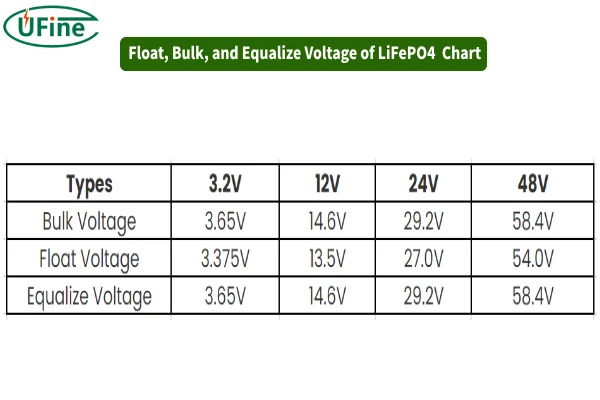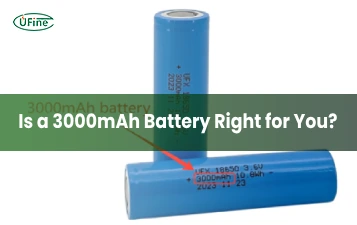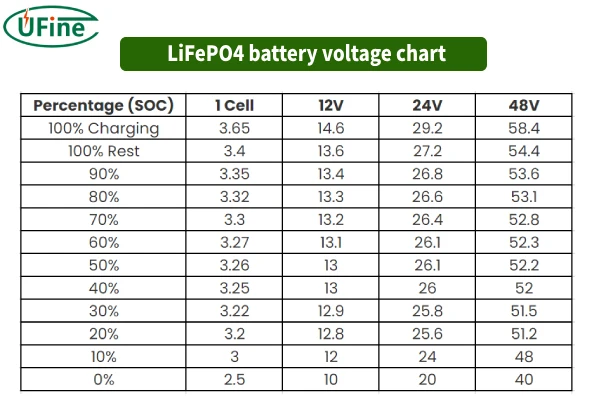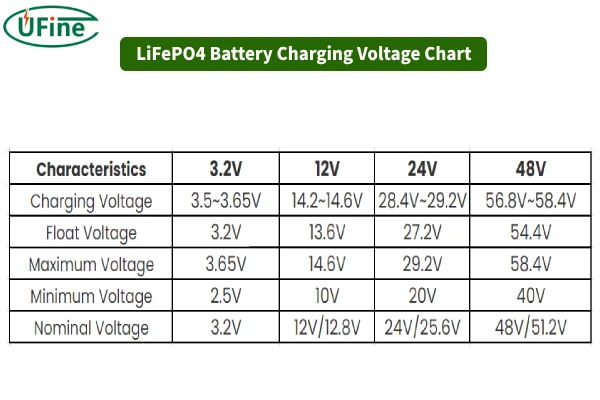You’re thinking about buying a LiFePO4 battery, huh? Fantastic choice! LiFePO4 batteries are well known for their safety, longevity, and overall efficiency. But before you rush out to get one, there’s something really important you need to understand: LiFePO4 cell voltage. Yep, knowing the ins and outs of this can make a huge difference in how well your battery performs and how long it lasts. In this article, we’ll break it all down for you in simple, easy-to-understand terms.
Part 1. LiFePO4 cell and LiFePO4 battery
Let’s talk about the difference between a LiFePO4 cell and a LiFePO4 battery. You might think they’re the same, but they’re not.
A LiFePO4 cell is the basic building block. It’s just one single unit with a specific voltage and capacity. On the other hand, a LiFePO4 battery is made up of several cells connected together. These cells can be arranged in series (to increase the voltage) or in parallel (to increase the capacity). So, when you’re looking at a LiFePO4 battery, you’re actually looking at a bunch of cells working together. Cool, right?
Let’s break it down a bit more. Imagine you have a single LiFePO4 cell. This cell has a nominal voltage of about 3.2V. Now, if you want a 12V LiFePO4 battery (which is common for things like RVs and small solar setups), you would need to connect four of these cells in series. This configuration is often written as 4S, where “S” stands for series. When connected in series, the voltages add up, giving you a total of 12.8V (3.2V x 4).
Now, if you need more capacity (more stored energy), you can connect multiple sets of these series-connected cells in parallel. For example, if you connect two 4S strings in parallel, you double the capacity while keeping the voltage the same. This configuration might be written as 4S2P (four cells in series, two sets in parallel).
Understanding this difference is crucial because the voltage of the battery depends on the configuration of its cells. And this configuration directly influences how the battery will perform in different applications.
Part 2. What is LiFePO4 cell voltage?

Now, let’s get to the heart of the matter: LiFePO4 cell voltage. This is the electrical potential difference between the positive and negative terminals of a single LiFePO4 cell. In simpler terms, it’s a measure of how much electrical energy is stored in the cell. And why is this important? Because the cell voltage tells you a lot about the battery’s state of charge (SOC) and overall health.
Think of the voltage like a fuel gauge for your battery. When the voltage is high, the battery is fully charged. When the voltage is low, the battery is running out of juice. Keeping an eye on the voltage helps you understand when it’s time to recharge and when the battery is at its optimal performance level.
Part 3. Optimal voltage range
So what’s the optimal voltage range for a LiFePO4 cell? Typically, you want to keep it between 2.5V and 3.65V. Why? Well, staying within this range helps ensure the battery performs efficiently and lasts a long time. If you go too high or too low, you could damage the cell and reduce its lifespan. So, think of this range as the sweet spot for your LiFePO4 battery.
When the voltage is within this optimal range, the battery operates efficiently. This means you get the most out of each charge cycle. Going outside this range can lead to problems. For example, if the voltage goes above 3.65V, the cell becomes overcharged, which can cause overheating and potential damage. On the other hand, if the voltage drops below 2.5V, the cell can experience deep discharge, which can also cause permanent damage.
Maintaining the optimal voltage range is like taking care of your car’s engine. You wouldn’t want to constantly rev it to the max or let it idle too low. Keeping it in the right range ensures smooth operation and a longer lifespan.
Part 4. Maximum voltage
Next up, let’s talk about the maximum voltage. For a LiFePO4 cell, this is around 3.65V. Charging your cell beyond this point can lead to overcharging. And trust me, you don’t want that. Overcharging can cause the cell to overheat and potentially damage it. So, always make sure your charger respects this limit. Better safe than sorry, right?
Overcharging is a serious issue because it can lead to thermal runaway—a condition where the cell gets so hot that it can catch fire or even explode. While LiFePO4 batteries are generally safer than other types of lithium-ion batteries, it’s still crucial to avoid pushing them beyond their limits.
Most quality LiFePO4 chargers and Battery Management Systems (BMS) are designed to prevent overcharging by cutting off the charge once the voltage reaches around 3.65V. Investing in a good charger with these safety features is well worth it.
Part 5. Minimum voltage
On the flip side, we have the minimum voltage, which is about 2.5V for a LiFePO4 cell. Letting the voltage drop below this level can lead to deep discharge. And deep discharge is a no-no because it can permanently damage the cell. So, it’s crucial to monitor the voltage and avoid letting it get too low. Think of it like not letting your phone battery die completely before charging it. Same idea!
Deep discharge can cause the cell’s internal structure to degrade, reducing its capacity and overall lifespan. In some cases, a deeply discharged cell may not be able to hold a charge at all. This is why many BMS systems include a low-voltage cutoff to prevent the cell from discharging too far.
Just like with overcharging, investing in a good BMS ologr voltage monitor can help you avoid the pitfalls of deep discharge. These systems automatically disconnect the load when the voltage gets too low, protecting your battery from damage.
Part 6. Common LiFePO4 battery voltage
Now, let’s look at some common LiFePO4 battery voltages and what they’re used for.
- 12V LiFePO4 Battery: Made up of 4 cells in series (4S). This is one of the most popular configurations. It’s made up of four cells connected in series, giving you a total voltage of around 12.8V. These batteries are commonly used in RVs, boats, and small solar power systems. They’re a great replacement for traditional lead-acid batteries because they offer a longer lifespan, lighter weight, and more consistent power output.
- 24V LiFePO4 Battery: Made of 8 cells in series (8S). This configuration consists of eight cells connected in series, giving you a total voltage of around 25.6V. These batteries are ideal for larger solar setups and some electric vehicles. They provide more power and capacity than the 12V configuration, making them suitable for more demanding applications.
- 36V LiFePO4 Battery: Composed of 12 cells in series (12S). Made of twelve cells connected in series, this configuration gives you a total voltage of around 38.4V. You’ll often find these batteries in electric bikes and scooters. They offer a good balance between power and weight, making them perfect for personal transportation devices.
- 48V LiFePO4 Battery: Made of 16 cells in series (16S). This is one of the highest voltage configurations, consisting of sixteen cells connected in series, giving you a total voltage of around 51.2V. These batteries are used in heavy-duty applications like electric cars and industrial equipment. They provide a lot of power and capacity, making them suitable for applications that require a lot of energy storage and output.
Choosing the right battery voltage depends on your specific needs. If you’re looking for a replacement for a lead-acid battery in your RV, a 12V LiFePO4 battery is a great choice. If you need more power for a larger solar setup or an electric vehicle, consider a 24V or 48V battery.
Part 7. How does LiFePO4 cell voltage affect battery performance?
So, how does LiFePO4 cell voltage affect battery performance? In many ways!
1.Efficiency
When your LiFePO4 battery operates within its optimal voltage range, it runs more efficiently. This means you get the most out of each charge cycle. For example, if you keep the voltage between 2.5V and 3.65V, the battery can deliver its energy more effectively, reducing energy loss and improving overall performance.
Think of it like driving a car. If you keep the engine within its optimal RPM range, you get better fuel efficiency and smoother performance. The same goes for your battery. Keeping it within the optimal voltage range ensures it runs at peak efficiency.
2. Safety
Safety is a big deal when it comes to batteries. Staying within the voltage limits helps prevent overheating and potential hazards. Overcharging or deep discharging can cause the battery to heat up, which can lead to fires or explosions in extreme cases.
LiFePO4 batteries are generally safer than other types of lithium-ion batteries, but it’s still important to take precautions. Using a charger and BMS that respect the voltage limits can help you avoid these safety risks.
3. Longevity
Proper voltage management extends the battery’s lifespan. If you consistently keep your battery within the optimal voltage range, it will last longer. Just like taking good care of a plant by giving it the right amount of water and sunlight, taking care of your battery by managing its voltage will help it live a longer, healthier life.
For example, if you avoid overcharging and deep discharging, the battery’s internal components will experience less stress and wear. This means the battery will maintain its capacity and performance for a longer period.
4. Capacity
The voltage of your battery affects how much energy it can store. Higher voltage means more stored energy, which is always a plus. When your battery operates within its optimal voltage range, it can deliver its full capacity, giving you more runtime and better performance.
For instance, if you’re using a 48V LiFePO4 battery for an electric car, keeping the voltage within the optimal range ensures you get the maximum driving range. If the voltage drops too low, the battery’s capacity decreases, reducing the distance you can travel on a single charge.
Part 8. How to check LiFePO4 cell voltage?
Now, let’s talk about how to check your LiFePO4 cell voltage. It’s pretty straightforward.
1.Using a Multimeter
A multimeter is a handy tool for measuring voltage. To check your LiFePO4 cell voltage, set the multimeter to measure DC voltage. Then, connect the positive probe to the positive terminal of the cell and the negative probe to the negative terminal. The multimeter will display the cell voltage.
Make sure to handle the probes carefully to avoid short-circuiting the cell. If you’re not familiar with using a multimeter, there are plenty of tutorials available online to help you get started.
2. Checking the BMS
Many LiFePO4 batteries come with a BMS that provides information about the battery’s status, including the voltage of each cell. The BMS monitors the voltage, temperature, and other parameters to ensure the battery operates safely and efficiently.
To check the voltage using the BMS, refer to the user manual for instructions on accessing the voltage readings. Some BMS systems have a display screen that shows the voltage, while others may require you to connect to a computer or smartphone app.
3. Using a Battery Monitor
A battery monitor is a device that continuously tracks the voltage and other parameters of your battery. It’s a great tool for keeping an eye on your battery’s health and performance. Some battery monitors are designed specifically for LiFePO4 batteries and can provide detailed information about each cell.
To install a battery monitor, follow the manufacturer’s instructions. Once installed, the monitor will display real-time voltage readings, allowing you to keep track of your battery’s status at all times.
Part 9. Final thoughts
And there you have it! Understanding LiFePO4 cell voltage is super important before buying a battery. It affects everything from efficiency and safety to longevity and capacity. Knowing the optimal, maximum, and minimum voltages helps you maintain your battery properly.
Related Tags:
More Articles

Is a 3000 mAh Lithium Battery Enough for Your Device?
Wondering what a 3000mAh battery means? Learn about its power, lifespan, types, and how to choose the best one for your device!
Learn About Lithium Battery Kits
Discover the ultimate guide to lithium battery kits—types, safety, installation, and cost analysis. Make the right choice for solar, RV, or off-grid power!
Selecting the Perfect Ah for Your 48V Li-ion Battery Pack
Struggling to choose the right Ah for your 48V Li-ion battery pack? This in-depth guide covers everything you need to make the best choice. Find out more now!
LiFePO4 Pouch Cells Explained: Advantages, Applications & Comparison
Learn all about LiFePO4 pouch cells, their structure, lifespan, advantages, and how they outperform other lithium battery types. Make the right choice!
12Ah Lithium Battery Guide: Uses, Lifespan & Tips
12Ah lithium batteries last longer, charge faster & weigh less than lead-acid. See best uses, charging tips & how to extend lifespan!







